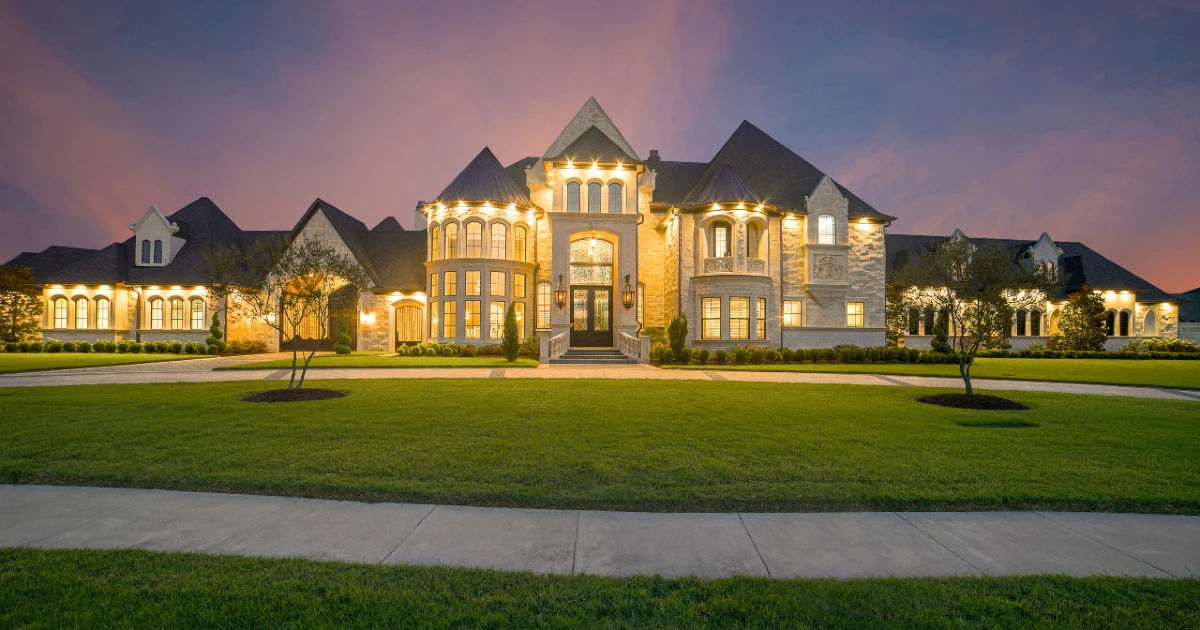Nebraska Real Estate Market Overview
The Nebraska real estate market reflects a landscape of steady growth and valuation. As of recent metrics, the median home value in Nebraska stands at $289,000, which marks a 1-Year Appreciation Rate of +3.2%. The median sale price has risen to $289,000, despite a slight decrease of 5.2% in the number of homes sold, which now totals 1,780.
Foreclosure rates have become a part of the conversation, contributing noteworthy figures to the national trends, with 267 foreclosures recorded in the first quarter of the market analysis. However, experts in the field are noticing signs of a market correction following the aggressive monetary policy by the Federal Reserve initiated in March 2022. Getting Nebraska rental property insurance can help protect your property.
Nebraska's housing market benefits from its wide-open spaces and more affordable living when compared to national averages. The median selling price of houses has been noted at $289,000 as per the latest collected data, representing a year-over-year increase of 3.2%.
- Median Home Value: $289,000
- 1-Year Appreciation Rate: +3.2%
- Median Sale Price: $289,000
- Number of Homes Sold: 1,780
- Foreclosures: 267 in the first quarter
The current real estate and housing market in Nebraska is a mix of upward trends in home values and an eye on the possible corrections due to economic policies. For those interested in the Nebraska housing market data, resources like the Nebraska - FortuneBuilders and Realtor.com® provide insightful overviews and analyses.
Historical Market Analysis in Nebraska
The historical perspective of Nebraska's real estate market reveals trends influenced by nationwide economic shifts and local demand patterns, with particular emphasis on the impacts of the 2021 time frame and the ongoing ramifications of the pandemic.
2021 Market Retrospective
In 2021, Nebraska's housing market exhibited resilience with an uptick in home values asserting a seller's market. According to Redfin, home prices saw a year-over-year increase of 4.5% in January 2021, paired with a rise in homes sold by 9.1%. These figures underscore a year of competitive housing dynamics despite economic uncertainties.
Pandemic Impact on Nebraska Housing
The pandemic catalyzed significant shifts in Nebraska's housing sector, including escalated demand and home valuations spurred by changes in buyer preferences and limited inventory. The Nebraska Real Estate Market Trends & Analysis demonstrates how affordability in the state, compared to its peers, has increased housing demand. The public health crisis further stressed the market, resulting in tightened inventory levels and pressuring prices upward.
Comparison With National Housing Market
When juxtaposed with the national housing market, Nebraska's real estate dynamics during the pandemic show proportionally fewer volatilities. Though the state followed the national trend of increased prices and demand, Nebraska's Real Estate Market Overview suggests a more balanced trajectory. With a predicted steady climb in median home prices into 2026, Nebraska contrasts with the much larger spikes seen in other U.S. regions, reflecting a market that is growing but stable.
Current Market Indicators in Nebraska
This section provides a concise overview of the key facets shaping the Nebraska Real Estate landscape as of January 2025, including housing statistics and various economic factors influencing the market.
January 2025 Housing Statistics
As of January 2025, the housing statistics reflect a nuanced picture of the Nebraska real estate market. The state has seen a series of fluctuations influenced by economic factors and seasonal adjustments.
Interest and Mortgage Rates
Mortgage rates are a critical component in assessing the affordability of homes. In Nebraska, as of January 2025, the prevailing 30-year fixed-rate mortgage stands at an average of 6.8%.
Inventory and Months of Supply
The inventory levels in Nebraska have seen an adjustment with a notable impact on the market. The months of supply, an indicator of how long current inventories would last at the current rate of sales activity, is approximately 2 months, signaling a competitive market.
Median Sale and Home Prices
The median sale price in Nebraska's housing market as of January 2025 remains robust. The median home price was last recorded at $289,000, marking an increase from the previous year. This figure conveys the sustained demand and the overarching trends of pricing in Nebraska's real estate environment.
Geographical Market Insights in Nebraska
The Nebraska real estate market exhibits distinct characteristics across different regions, reflecting unique trends and dynamics within local markets. As buyers and sellers navigate these areas, they encounter varying conditions in Omaha, Lincoln, Bellevue, Grand Island, and Kearney.
Omaha Real Estate Trends
In Omaha, the market continues to witness a robust demand for housing. Homes in Omaha are selling relatively quickly due to the city's strong economic foundations and a growing population. Recent data suggests a steady increase in median home values, indicating a continued competitive market for buyers.
Lincoln Market Dynamics
Lincoln, the state capital, showcases a dynamic real estate environment. The area's market is bolstered by its status as an educational hub, with positive implications on the housing demands. The city's employment opportunities draw in an audience that contributes to a consistent turnover in property sales.
Rise of Bellevue and Surrounding Areas
Bellevue has observed a surge in housing interest, partly attributed to its proximity to Omaha. Coupled with Papillion homes, the area is experiencing growth, making it a focal point for real estate development and investment. This region is becoming attractive to those seeking a balance between urban accessibility and suburban comfort.
Grand Island and Kearney Markets
Further west, Grand Island and Kearney's real estate markets present opportunities with more affordable pricing compared to the state's larger cities. Although these markets move at a different pace, they hold appeal for those looking for value and potential in their real estate investments.
By understanding these geographical market insights, stakeholders in the Nebraska real estate sector can make more informed decisions tailored to each region's unique landscape.
Demographic and Economic Factors in Nebraska
The demographic and economic landscape of Nebraska plays a crucial role in shaping the real estate market. Factors such as population growth, unemployment rates, housing affordability, and migration patterns influenced by remote work are pivotal in understanding market dynamics.
Population Growth Impact
Nebraska has experienced consistent population growth, bolstering the demand for housing. This growth is reflective of the state's economic stability and can be linked to a resulting uptick in real estate development. With a steady influx of residents, the housing market remains vibrant as the supply strives to meet the increasing demand.
Unemployment and Housing Affordability
The state's unemployment rate is a critical economic indicator affecting the real estate market. Nebraska's unemployment levels have historically been lower than the national average, contributing to a relatively stable housing market. Housing affordability remains a concern, however, as rising prices can outpace income growth, affecting buyers' ability to purchase homes.
Remote Work and Migration Patterns
The onset of COVID-19 and the rise of remote work have altered migration patterns, with a noticeable shift towards suburban and rural areas. This shift has borne out in Nebraska, where the appeal of less densely populated areas has grown. Migration to these areas is facilitated by the increasing possibility of remote work, impacting real estate demand in smaller towns and communities.
Market Challenges and Opportunities in Nebraska
Navigating the Nebraska real estate market involves strategic consideration of various challenges and opportunities. This section will analyze pressing issues like low inventory, the competitive landscape for buyers, and effective strategies for sellers in today's market environment.
Dealing With Low Inventory
In Nebraska, limited housing inventory has been a consistent market trend, leading to increased prices. According to recent data, the average median home price in the state is $289,000, up by 3.2% year over year. Buyers must contend with fewer homes for sale which may drive up housing demand.
Understanding Buyer Competition
Buyer competition in Nebraska has remained strong due to the combination of low inventory and sustained demand. Prospective homeowners often find themselves in bidding wars, with homes selling rapidly, sometimes above the listing price. One report demonstrates a sale-to-list price ratio at 99.1%, indicating high competition among buyers.
Seller Strategies in Current Market
Sellers in Nebraska can capitalize on the current market trends by understanding the competitive landscape. With demand outweighing supply, sellers have the opportunity to price their homes strategically to prompt multiple offers. Successful seller strategies also involve timing the market correctly to maximize returns and minimize time on the market.
Real Estate Transactions Details in Nebraska
In Nebraska's real estate market, understanding the specifics of foreclosures, property pricing, and down payments is essential for both buyers and sellers to navigate transactions effectively. Getting landlord insurance in Nebraska before the rental agreement can help pay for accidental damages.
Navigating Foreclosures and Sales
When dealing with foreclosures in Nebraska, it's important to recognize that these properties can significantly influence market trends. In the first quarter, Nebraska saw 267 foreclosures, affecting supply and potentially offering opportunities for investors. For those interested in purchasing a foreclosure, they must be aware of the necessary steps to take, which include attending auctions and understanding foreclosure filing procedures.
Essentials of Property Pricing
Determining a property's price hinges on factors such as location, condition, and the current market environment in Nebraska. Property prices have been rising with a significant 1-Year Appreciation Rate of +3.2%. When pricing a home for sale, sellers should consider recent comparable sales and any unique features that might add value to their home.
The Impact of Down Payments
The size of a down payment plays a critical role in the real estate transaction process. It affects loan terms, interest rates, and even buyer eligibility. For example, a larger down payment might reduce the need for mortgage insurance, while in competitive market conditions, it might make an offer more appealing to sellers. Understanding these dynamics is crucial for buyers when they enter the market. Consider getting landlord insurance in Nebraska before the rental agreement starts to cover any damages.
Investment Perspective in Nebraska
In Nebraska's real estate market, investors consider home value trends, the viability of real estate as an investment vehicle, and the sector's reaction to economic changes.
Value Projection for Homes
Nebraska's median home value has become a critical metric for understanding future potential in real estate. Recent data indicates a sustained increase in home values, signaling a positive trend for homeowners and investors alike. For instance, the [3Q21 US Volume](https://nic.nebraska.gov/sites/default/files/doc/3Q 2021 Real Estate Performance.pdf) saw significant growth, indicative of a robust market.
Real Estate as an Investment Option
Real estate in Nebraska has proven to be a strong investment option due to its steady performance and resilience. Investors looking for long-term stability often turn towards property investment, attracted by the tangible nature of the asset and the historical performance outlined in market analyses, such as the [Nebraska Investment Council's Real Estate Market Updates](https://nic.nebraska.gov/sites/nic.nebraska.gov/files/doc/7.a. Real Estate Performance Review.pdf), which show promising returns.
Market Response to Economic Fluctuations
The Nebraska real estate market has exhibited responsiveness to economic fluctuations, including interest rate changes by the Federal Reserve and various stages of economic cycles. Despite the challenges posed by certain events, like recessions or other economic downturns, the market has displayed a degree of resilience. This reaction to economic stressors is important for investors to consider when evaluating the risk and return profile of real estate investments.
Future Outlook in Nebraska
The real estate market in Nebraska continues to evolve with changing economic conditions, presenting a mix of challenges and opportunities for potential homeowners and investors.
Predictions and Market Trends
Experts anticipate a continued rise in the median sale price of homes in Nebraska due to tight inventory, a trend contributing to the state's housing dynamics. Historical data suggests a steady upward trajectory in home values, with gains consistent over the past decade. For instance, the average median home price in Nebraska has climbed significantly year over year. The market trends also reflect a strong sale-to-list price ratio, indicating a competitive environment for buyers.
Impact of New Home Construction
New home construction plays a pivotal role in addressing the housing supply challenges in Nebraska. An increase in construction activities could potentially stabilize the market by meeting the high demand for housing. However, the pace of new developments could also influence overall market conditions, impacting both homeownership rates and the best time to buy a house in Nebraska.
Buying vs. Renting Considerations
When exploring buying vs. renting in Nebraska, one must consider the long-term benefits of homeownership against the flexibility of renting. While the upfront costs and responsibilities associated with buying a home are significant, the potential for value appreciation over time can tip the scales in favor of purchasing. First-time buyers especially should monitor the market closely for opportunities to invest when conditions are more favorable.
Practical Advice for Market Participants in Nebraska
The Nebraska real estate market offers unique opportunities for both buyers and sellers. This section provides targeted advice to help market participants navigate the landscape effectively.
First-Time Homebuyers' Guide
First-time homebuyers in Nebraska should prioritize financial readiness and market research. They can benefit from:
- Understanding Local Market Trends: Homes in Nebraska have seen a consistent increase in value, thus timing the market is less crucial than finding the right home that meets their needs.
- Exploring Financing Options: Mortgage rates and programs vary, so it's essential to explore all available options and secure pre-approval before house hunting.
Tips for Sellers in Current Market
Sellers aiming to capitalize on the current market should focus on strategic pricing and presenting their property favorably:
- Setting the Right Price: An accurate home valuation is key. Even in a sellers' market, setting a price that reflects the true market value of a property can help attract serious buyers.
- Effective Marketing:
- High-Quality Photos: Listings with professional photos generally draw more attention.
- Property Staging: A well-staged home can highlight the property's best features.
Preparing for Market Fluctuations
Both buyers and sellers should be equipped to adjust to market changes:
- Regular Market Updates: Keeping informed about the latest market trends, such as the current inventory levels and mortgage rate changes, can inform better decision-making.
- Adaptability: Being open to adjusting strategies, whether in terms of pricing or the timing of buying or selling, will be an asset in a fluctuating market.
Additional Resources and Tools in Nebraska
In the quest to navigate Nebraska's real estate landscape, homebuyers and sellers can capitalize on a suite of tools and resources designed to inform and guide their decisions. These platforms not only provide a pulse on housing prices and days on the market but also offer insights on trends such as foreclosure activity.
Utilizing MLS and Real Estate Platforms
Multiple Listing Service (MLS) systems serve as a pivotal resource for anyone interested in the Nebraska realty market. By providing up-to-date listings, MLS platforms ensure users have access to comprehensive data on properties currently for sale, including days on the market and pricing. For a more consumer-centric experience, platforms like Zillow give potential buyers a user-friendly interface to browse homes, evaluate market trends, and monitor housing prices with relative ease.
Nebraska Realty, a local MLS-powered platform, merges regional expertise with a wealth of listing information, helping users make informed decisions in their property search. This becomes especially useful when examining the nuances of foreclosure listings and foreclosure activity in Nebraska, an aspect critical for investors or bargain-seeking homebuyers.
Nebraska Realty Market Reports
Market reports, such as those powered by ATTOM, play a critical role in presenting an aggregated view of the real estate environment. Detailed analyses can reveal patterns in days on market, shifts in median housing prices, and the prevalence of foreclosures. By routinely studying these reports, stakeholders gain a clear, data-driven picture of market health and can better predict future movements.
Nebraska Investment Council provides quarterly reports on real estate performance, offering insights into the fiscal strength of property investments across the state. Whether for seasoned investors or first-time buyers, these resources are invaluable for staying ahead in the Nebraska real estate market.
Frequently Asked Questions
In this section, we address some of the most pressing queries regarding the current state and future predictions of the Nebraska real estate market, providing insights grounded in available data and market analysis.
What trends are currently influencing the Nebraska housing market?
The Nebraska housing market is characterized by a modest month-over-month increase in home values and a relatively low housing inventory. These conditions have persisted since at least May 2022, indicating a stable, yet competitive market.
How has the average house price in Omaha, Nebraska changed over recent years?
Omaha, the largest city in Nebraska, has seen a consistent rise in house prices over the years, reflecting broader state trends. Particularly in 2023, the Nebraska real estate guide suggests that despite market uncertainties, the city has maintained its stride with affordable housing options amidst a strong job market.
What are experts predicting for the Nebraska real estate market in the next 5 years?
Experts forecast that the median sale price may increase due to ongoing tight inventory conditions. This prediction suggests sustained or possibly escalated demand vis-à-vis the supply over the next half-decade.
What factors are contributing to the cost of homes in Nebraska?
Several factors impact home costs in Nebraska, including low housing inventory, which, according to historical data, has increased competition and, subsequently, prices. Additionally, economic dynamics like mortgage interest rates and local job market stability play significant roles.
Could the Nebraska housing market be facing a downturn or crash in the near future?
Given the complexity of housing markets, absolute predictions are challenging; however, while the Nebraska housing market has experienced price increases, sales volume had a notable downtick. This could indicate a potential adjustment period but not necessarily a crash.
Is the Omaha real estate market currently favoring buyers or sellers?
The climate of Omaha's real estate market tends to lean in favor of sellers due to the low inventory and sustained demand. Such conditions often create a competitive environment for buyers, reinforcing a seller's market.






.png)
.jpg)
.jpg)


.png)